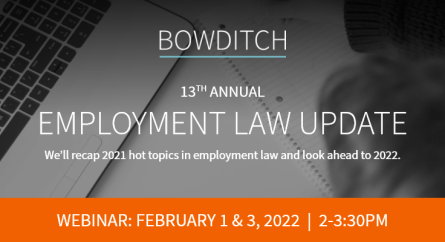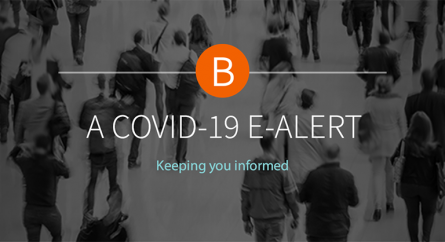Family and Medical Leave Program Draft Regulations Released
On January 23, the Massachusetts Department of Family and Medical Leave (the “Department”) published draft regulations (the “Regulations”) regarding the newly created Paid Family and Medical Leave Program (the “Program”). The Regulations expand upon legislation enacted this past summer (Acts 2018, c. 121, the “Act”) requiring private employers of all sizes to make contributions to the Program and provide leave to eligible employees. Employers must also provide leave to independent contractors who opt into the Program and cover the contributions themselves (collectively, employees and independent contractors are referred to as “eligible individuals”).
As specified under the Act, eligible individuals are entitled to job-protected, paid leave for up to 12 weeks per year to care for a sick family member or child, up to 20 weeks per year to attend to the individual’s own serious health condition, and up to 26 weeks per year to deal with an emergency related to the deployment of a family member for military service. Each eligible individual may take a maximum of 26 weeks of leave under the Program each year.
While the Act was light on language directed at employers, the Regulations raise the following new obligations for employers:
Obligation to Submit Quarterly Filings
At the end of each calendar quarter, employers must file a report containing the name, social security number, wages and other earnings paid to each employee. Employers must also report the federal employer identification number and the identification number that the employer is required to include on a withholding tax return filed under M.G.L. c. 62B, as well as the names, social security numbers and payments made to individuals for services that are reported on an IRS Form 1099-MISC. Employers must submit the quarterly filings to the Department through the MassTaxConnect system.
Obligation to Respond to Department Requests
The Act already provided that an employer must respond to any request regarding wage, earnings or employment information for any eligible individual within 10 calendar days after the date that the request was sent. The Regulations also mandate that, upon request, employers will have 5 calendar days to provide the Department with information or records relevant to a claim for benefits, including (a) wages and/or earnings for the past 12 months, (b) a job description, (c) whether the eligible individual works a full- or part-time schedule, (d) weekly hours worked, (e) prior requests/approvals for a “qualifying reason,” (f) amount of paid leave already taken for a “qualifying reason” during the current benefit year, (g) a description of the employer’s paid leave policies, and whether the eligible individual has received benefits during the current benefit year or will receive benefits during the requested leave, and (h) “[a]ny other relevant information or records related to the claim.”
Obligation to Update
The Regulations provide that in the case of a “change in relevant circumstances” that might extend, reduce or modify the amount of benefits or length of leave, both the eligible individual and the employer have an affirmative obligation to inform the Department of this change using Department-provided forms. The Regulations do not define which circumstances constitute a “change in relevant circumstances.”
Obligation Not to Retaliate
As provided in the Act, employers may not retaliate against employees for their participation in the Program, “through the application of attendance policies or otherwise.” The Regulations, however, provide that an employee who has been approved for leave benefits “must still comply with any attendance and call in procedures established by the employer.” Further, employees on intermittent leave must report to work at times agreed upon with the employer and may not “unduly disrupt the employer’s operation.” The Regulation provides that all employees must return to work following the expiration of the leave period.
However, employers should be wary of imposing discipline on employees exercising their rights under the Program, including discipline for the violation of an attendance policy. The Regulations specify that employees must be permitted to return to work after their leave to the same or equivalent position, with the same status, pay, benefits, length-of-service credit and seniority as they had on the date of leave. Any action taken against the employee to prevent this return, including non-disciplinary changes to their role, during or within six months of leave will be presumed retaliation. An employer may only overcome this presumption with “clear or convincing evidence” that their decision to discipline was non-retaliatory.
Obligation to Make Contributions
While not specifically included in the Regulations, the Department also released the initial contribution rates for each leave. Of the total contribution rate of 0.63% (amount to be adjusted annually) of an eligible individual’s $128,400 in earnings (based on the maximum wage base tied to the federal Social Security Administration’s annually-calculated contribution and benefit base), 0.52% will be allocated to medical leave and 0.11% will be allocated to family leave. Per the Act, employers are required to contribute a minimum of 60% of the medical leave contribution, but are not required to contribute to the family leave contribution.
Importance of Reviewing the Regulations
The information above is a summary of the major employer obligations included in the Regulations. As the Regulations provide additional information on the Program specifics, employers should comprehensively review the Regulations.
The Regulations are only in draft form, and further revisions are expected before the Regulations are finalized. However, after reviewing the Regulations in full, employers should submit any questions or comments to the Department for consideration in drafting the final regulations. Between January 30 and February 19, employers will also have the opportunity to share their informal comments with the Department at listening sessions throughout the state (see the Department’s website for specific dates and locations). The Regulations will be re-published for formal public comment on or before March 29, 2019. The Department expects that, after an opportunity for public comment, the final regulations will be promulgated and employer contributions will begin as of July 1, 2019.
This article was published by the Human Resources Management Association (HRMA).
Categorized: Employment, Workplace
Tagged In: employment, Massachusetts employers, paid family and medical leave law












